Price is nearing the next target and more importantly the upper edge of a multi-year trend channel. A reaction downwards from there would be fairly likely.
Summary: The next target is at 3,323 or 3,332. Look for strong resistance at the upper edge of the wide channel on weekly and daily charts.
It is possible that minor wave 3 could be over. Some confidence in this view may be had with a new low below 3,258.14. There is now some weakness developing. The risk of a larger pullback or consolidation beginning here or very soon is now high.
Three large pullbacks or consolidations (fourth waves) during the next 1-2 years are expected: for minor wave 4 (coming soon, possibly just begun), then intermediate (4), and then primary 4.
The biggest picture, Grand Super Cycle analysis, is here.
Monthly charts were last published here, with video here. There are two further alternate monthly charts here, with video here.
ELLIOTT WAVE COUNTS
The two weekly Elliott wave counts below will be labelled First and Second. They may be about of even probability. When the fifth wave currently unfolding on weekly charts may be complete, then these two wave counts will diverge on the severity of the expected following bear market. To see an illustration of this future divergence monthly charts should be viewed.
FIRST WAVE COUNT
WEEKLY CHART
The basic Elliott wave structure consists of a five wave structure up followed by a three wave structure down (for a bull market). This wave count sees the bull market beginning in March 2009 as an incomplete five wave impulse and now within the last fifth wave, which is labelled cycle wave V. This impulse is best viewed on monthly charts. The weekly chart focusses on the end of it.
Elliott wave is fractal. This fifth wave labelled cycle wave V may end a larger fifth wave labelled Super Cycle wave (V), which may end a larger first wave labelled Grand Super Cycle wave I.
The teal Elliott channel is drawn using Elliott’s first technique about the impulse of Super Cycle wave (V). Draw the first trend line from the end of cycle wave I (off to the left of the chart, the weekly candlestick beginning 30th November 2014) to the end of cycle wave III, then place a parallel copy on the end of cycle wave II (off to the left of the chart, the weekly candlestick beginning 14th February 2016). This channel perfectly shows where cycle wave IV ended at support. The strongest portion of cycle wave III, the end of primary wave 3, overshoots the upper edge of the channel. This is a typical look for a third wave and suggests the channel is drawn correctly and the way the impulse is counted is correct.
Within Super Cycle wave (V), cycle wave III is shorter than cycle wave I. A core Elliott wave rule states that a third wave may never be the shortest. For this rule to be met in this instance, cycle wave V may not be longer in length than cycle wave III. This limit is at 3,477.39. This rule is absolute, so this is a hard limit for this wave count. If price moves above this limit, then this wave count is invalidated and one of the more bullish alternate monthly wave counts would then be used.
Cycle wave V may subdivide either as an impulse or an ending diagonal. Impulses are much more common, and it is clear at this stage that cycle wave V is an impulse and not a diagonal.
At this stage, cycle wave V may take another one to two or so years to complete.
The daily chart below will focus on movement from the end of intermediate wave (2) within primary wave 3.
In historic analysis, two further monthly charts have been published that do not have a limit to upwards movement and are more bullish than this wave count. Members are encouraged to consider those possibilities (links below summary) alongside the wave counts presented on a daily and weekly basis. It is my judgement that the two weekly wave counts published in this analysis have the highest probability, so they shall be the only wave counts published on a daily basis while they remain valid.
Within cycle wave V, primary waves 1 and 2 may be complete. Within primary wave 3, intermediate waves (1) and (2) may be complete. Within the middle of intermediate wave (3), minor wave 4 may not move into minor wave 1 price territory below 3,021.99.
DAILY CHART
All of primary wave 3, intermediate wave (3) and minor wave 3 may only subdivide as impulses.
Minor wave 3 has passed 1.618 the length of minor wave 1, and within it minute wave v has passed equality in length with minute wave i. The next possible target for minor wave 3 may be at 3,332 where minute wave v would reach equality in length with minute wave iii.
When minor waves 3 and 4 may be complete, then a target will again be calculated for intermediate wave (3).
Minor wave 2 was a sharp deep pullback, so minor wave 4 may be expected to be a very shallow sideways consolidation to exhibit alternation. Minor wave 2 lasted 2 weeks. Minor wave 4 may be about the same duration, or it may be a longer lasting consolidation. Minor wave 4 may end within the price territory of the fourth wave of one lesser degree; minute wave iv has its range from 3,154.26 to 3,070.49.
Minor wave 4 may not move into minor wave 1 price territory below 3,021.99.
Intermediate wave (3) has now moved far enough above the end of intermediate wave (1) to allow intermediate wave (4) to unfold and remain above intermediate wave (1) price territory.
Draw an acceleration channel now about intermediate wave (3): draw the first trend line from the end of minor wave 1 to the last high, then place a parallel copy on the end of minor wave 2. Keep redrawing the channel as price makes new highs. Minor wave 4 may find support at the lower edge of this channel if it is long lasting or deep enough.
Price is approaching the upper edge of the wide teal channel copied over from monthly and weekly charts. If price gets up to this trend line, then a reaction downwards there would be highly likely. It now looks like this may be where minor wave 3 may end.
HOURLY CHART
It is possible that minor wave 3 may be close to completion.
Within minuette wave (v), subminuette waves i through to iv may be complete. A new target is now calculated at subminuette degree. If price reaches this first target and the structure is incomplete, or if price rises through the first target, then use the second target.
If it continues further, then subminuette wave iv may not move into subminuette wave i price territory below 3,258.14.
ALTERNATE HOURLY CHART
If price breaks below 3,258.14, then assume minor wave 4 has arrived. At that stage, this alternate wave count would increase in probability, but would still not be a certainty.
A correction to last about two weeks should begin with a five down on the hourly chart.
With a downturn at the end of this session, an invalidation point for this alternate may be set.
Minor wave 4 may end within the price territory of the fourth wave of one lesser degree. Minute wave iv has its range from 3,154.26 to 3,070.49. If this target range is wrong, then it may be too low.
SECOND WAVE COUNT
WEEKLY CHART
This weekly chart is almost identical to the first weekly chart, with the sole exception being the degree of labelling.
This weekly chart moves the degree of labelling for the impulse beginning in March 2009 all down one degree. This difference is best viewed on monthly charts.
The impulse is still viewed as nearing an end; a fifth wave is still seen as needing to complete higher. This wave count labels it primary wave 5. Primary wave 5 may still need another year to two or so to complete, depending upon how time consuming the corrections within it may be.
Primary wave 5 may be subdividing as an impulse, in the same way that cycle wave V is seen for the first weekly chart.
TECHNICAL ANALYSIS
WEEKLY CHART

Click chart to enlarge. Chart courtesy of StockCharts.com.
It is very clear that the S&P is in an upwards trend and the bull market is continuing. Price does not move in straight lines; there will be pullbacks and consolidations along the way.
This chart is overall bullish. There are no signs of short-term weakness in upwards movement.
RSI is now overbought. That does not mean upwards movement must end here, because it can continue for several weeks while RSI reaches more extreme. RSI reaching overbought is a warning that conditions are now becoming extreme. A pullback or consolidation will follow and the longer conditions are extreme the closer this will be. However, assume the trend remains the same until proven otherwise. This warning should be heeded by careful attention to risk management.
Last week completes a strong bullish candlestick with some support from volume. The trend remains upwards, for now.
DAILY CHART

Click chart to enlarge. Chart courtesy of StockCharts.com.
There is an upwards trend in place. There will be corrections along the way.
Like the weekly chart, this chart is bullish.
RSI now exhibits triple bearish divergence while overbought. This is often (not always) a warning of a pullback or consolidation to develop.
Corrections for this market can sometimes arrive with very little warning. Extreme conditions warrant more careful attention to risk management. Upwards movement could continue yet for a reasonable distance and time, but the risk of a consolidation or pullback is increasing.
BREADTH – AD LINE
WEEKLY CHART
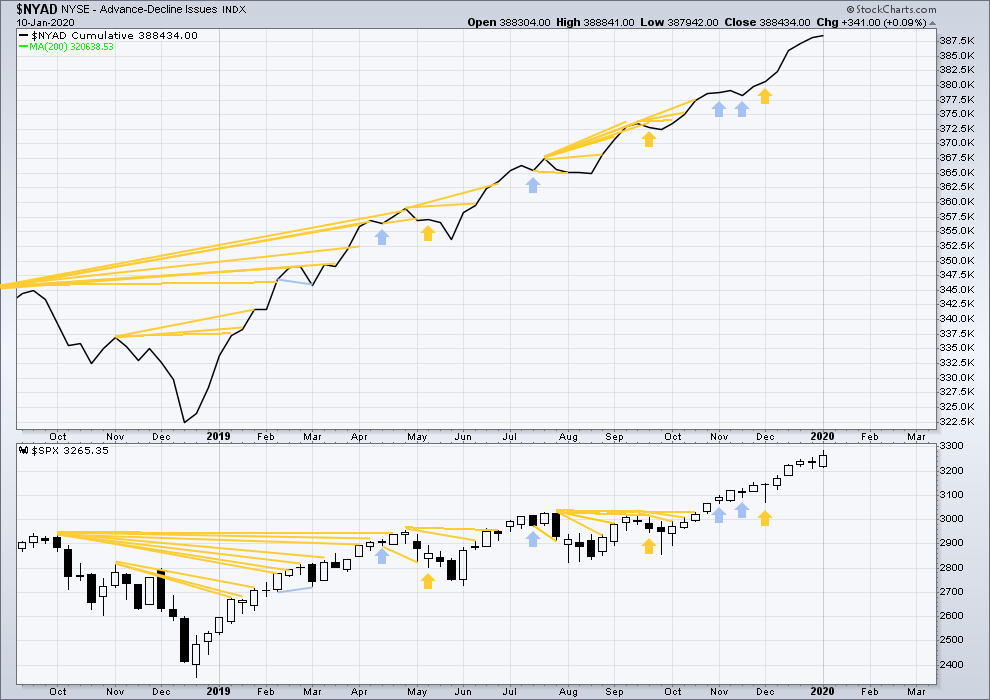
Click chart to enlarge. Chart courtesy of StockCharts.com. So that colour blind members are included, bearish signals
will be noted with blue and bullish signals with yellow.
Bear markets from the Great Depression and onwards have been preceded by an average minimum of 4 months divergence between price and the AD line with only two exceptions in 1946 and 1976. With the AD line making new all time highs this week, the end of this bull market and the start of a new bear market is very likely a minimum of 4 months away, which is mid May 2020.
In all bear markets in the last 90 years there is some positive correlation (0.6022) between the length of bearish divergence and the depth of the following bear market. No to little divergence is correlated with more shallow bear markets. Longer divergence is correlated with deeper bear markets.
If a bear market does develop here, it comes after no bearish divergence. It would therefore more likely be shallow.
Again both price and the AD line have made new all time highs. There is no divergence. Upwards movement has support from rising market breadth.
Large caps all time high: 3,298.55 on 15th January 2020.
Mid caps all time high: 2,084.50 on 15th January 2020.
Small caps all time high: 1,100.58 on 27th August 2018.
Current upwards movement is driven by large caps, which is a feature of an aged bull market.
DAILY CHART

Click chart to enlarge. Chart courtesy of StockCharts.com. So that colour blind members are included, bearish signals
will be noted with blue and bullish signals with yellow.
Breadth should be read as a leading indicator.
Upwards movement today again sees new all time highs in both price and the AD line. Upwards movement has support from rising market breadth. This is bullish.
Large caps have for the short term made new highs, but mid and small caps have not made new swing highs above prior highs of the 2nd of January. There is now short-term weakness developing.
VOLATILITY – INVERTED VIX CHART
WEEKLY CHART

Click chart to enlarge. Chart courtesy of StockCharts.com. So that colour blind members are included, bearish signals
will be noted with blue and bullish signals with yellow.
The all time high for inverted VIX was on 30th October 2017. There is now over two years of bearish divergence between price and inverted VIX.
The rise in price is not coming with a normal corresponding decline in VIX; VIX remains elevated. This long-term divergence is bearish and may yet develop further as the bull market matures.
This divergence may be an early warning, a part of the process of a top developing that may take years. It may is clearly not useful in timing a trend change from bull to a fully fledged bear market.
Last week price and inverted VIX have both moved higher. Price is making new highs, but there remains all of short, mid and long-term bearish divergence with inverted VIX.
DAILY CHART
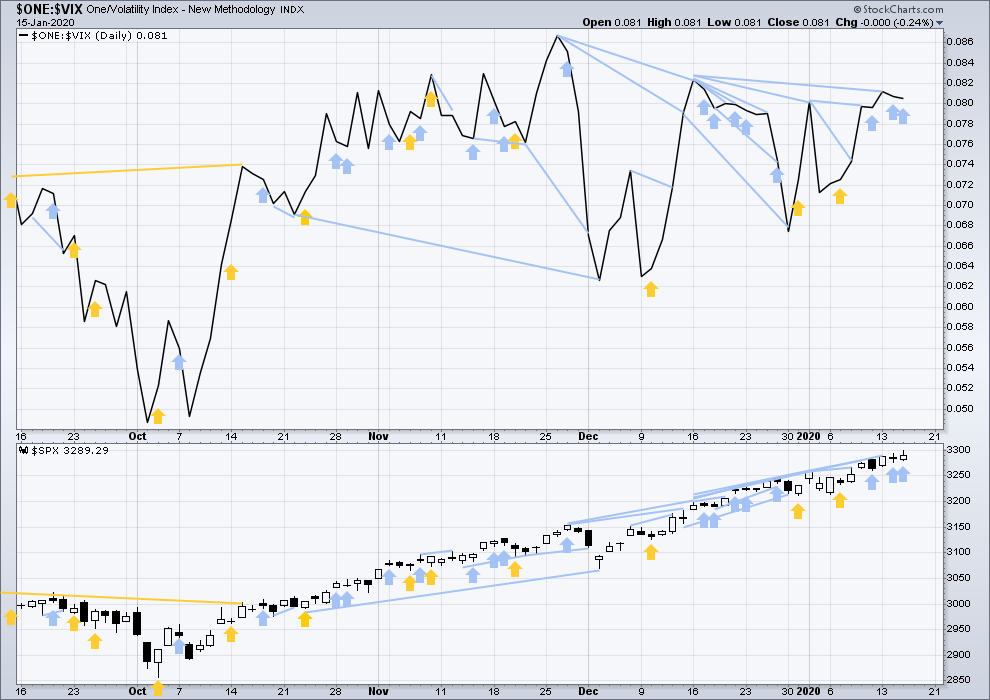
Click chart to enlarge. Chart courtesy of StockCharts.com. So that colour blind members are included, bearish signals
will be noted with blue and bullish signals with yellow.
Again, today price has moved higher, but inverted VIX has moved lower. This divergence is bearish for the short term. There is now a small cluster of bearish signals from inverted VIX. This may develop a little further before minor wave 4 arrives, and it may be a warning that minor wave 4 may begin soon.
DOW THEORY
Dow Theory confirmed a bear market in December 2018. This does not necessarily mean a bear market at Grand Super Cycle degree though; Dow Theory makes no comment on Elliott wave counts. On the 25th of August 2015 Dow Theory also confirmed a bear market. The Elliott wave count sees that as part of cycle wave II. After Dow Theory confirmation of a bear market in August 2015, price went on to make new all time highs and the bull market continued.
DJIA: 23,344.52 – a close on the 19th of December at 23,284.97 confirms a bear market.
DJT: 9,806.79 – price has closed below this point on the 13th of December.
S&P500: 2,532.69 – a close on the 19th of December at 2,506.96 provides support to a bear market conclusion.
Nasdaq: 6,630.67 – a close on the 19th of December at 6,618.86 provides support to a bear market conclusion.
With all the indices having moved higher following a Dow Theory bear market confirmation, Dow Theory would confirm a bull market if the following highs are made:
DJIA: 26,951.81 – a close above this point has been made on the 3rd of July 2019.
DJT: 11,623.58 – to date DJT has failed to confirm an ongoing bull market.
S&P500: 2,940.91 – a close above this point was made on the 29th of April 2019.
Nasdaq: 8,133.30 – a close above this point was made on the 26th of April 2019.
Published @ 06:43 p.m. EST.
—
Careful risk management protects your trading account(s).
Follow my two Golden Rules:
1. Always trade with stops.
2. Risk only 1-5% of equity on any one trade.
—
New updates to this analysis are in bold.

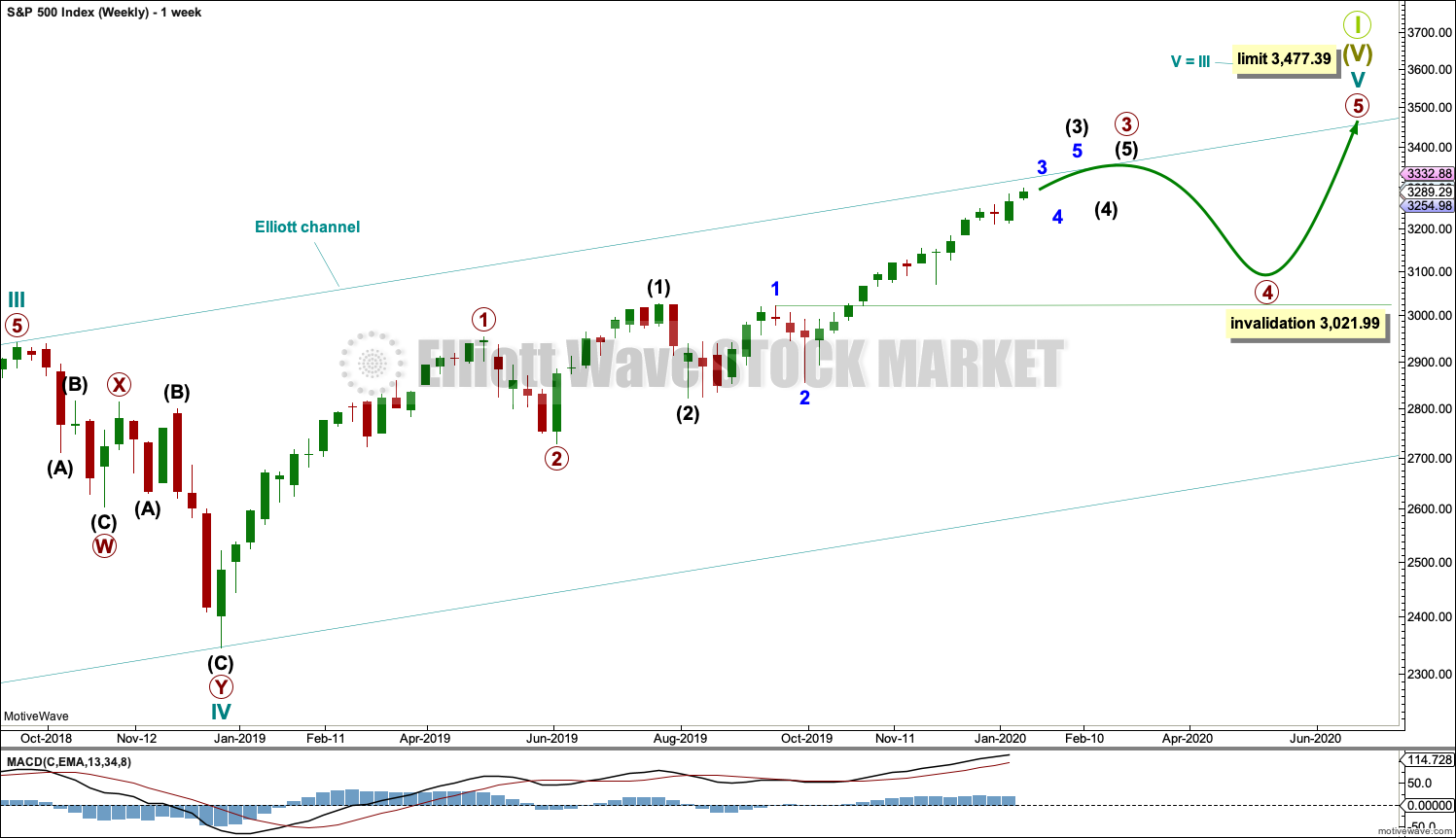
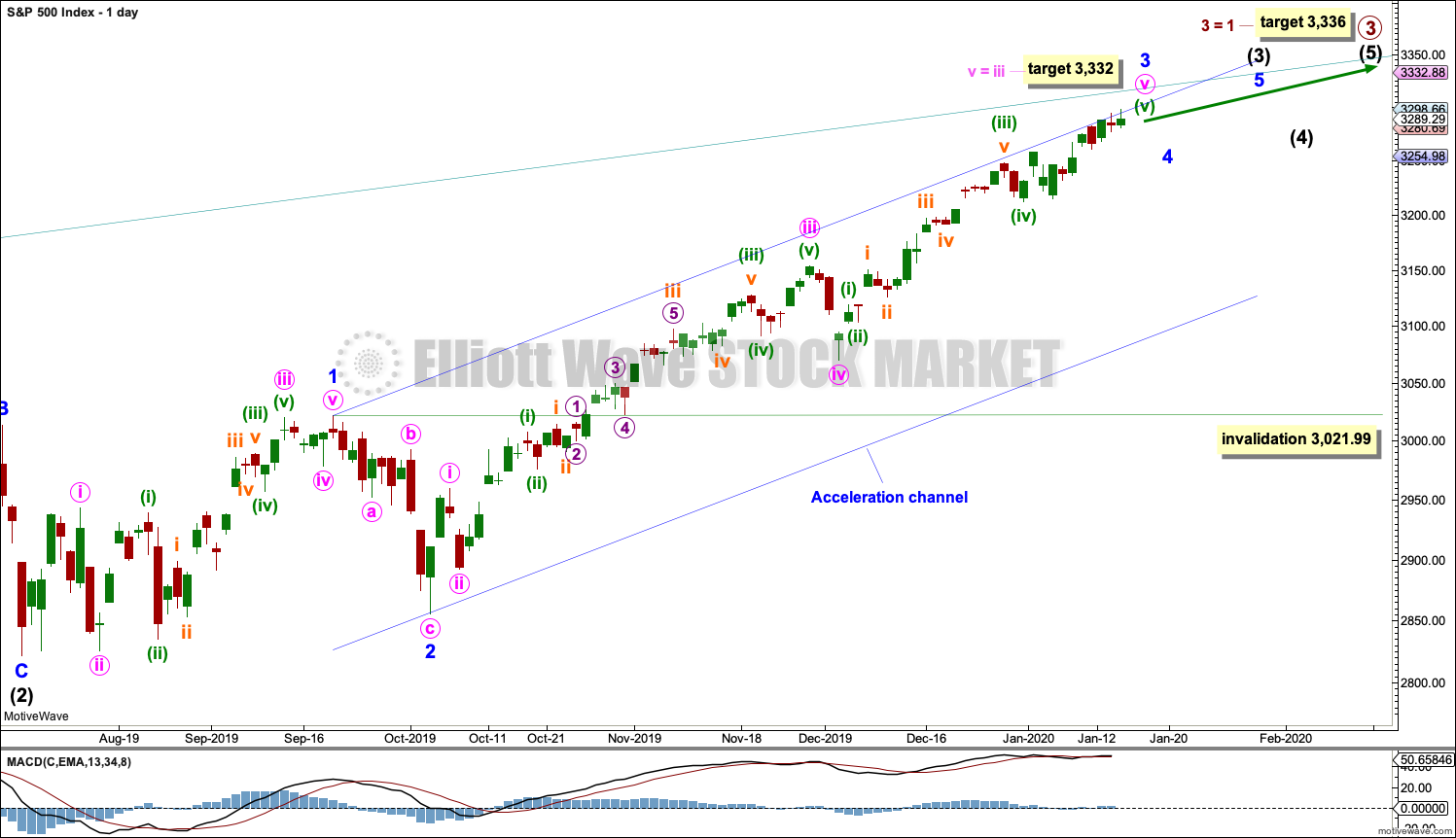
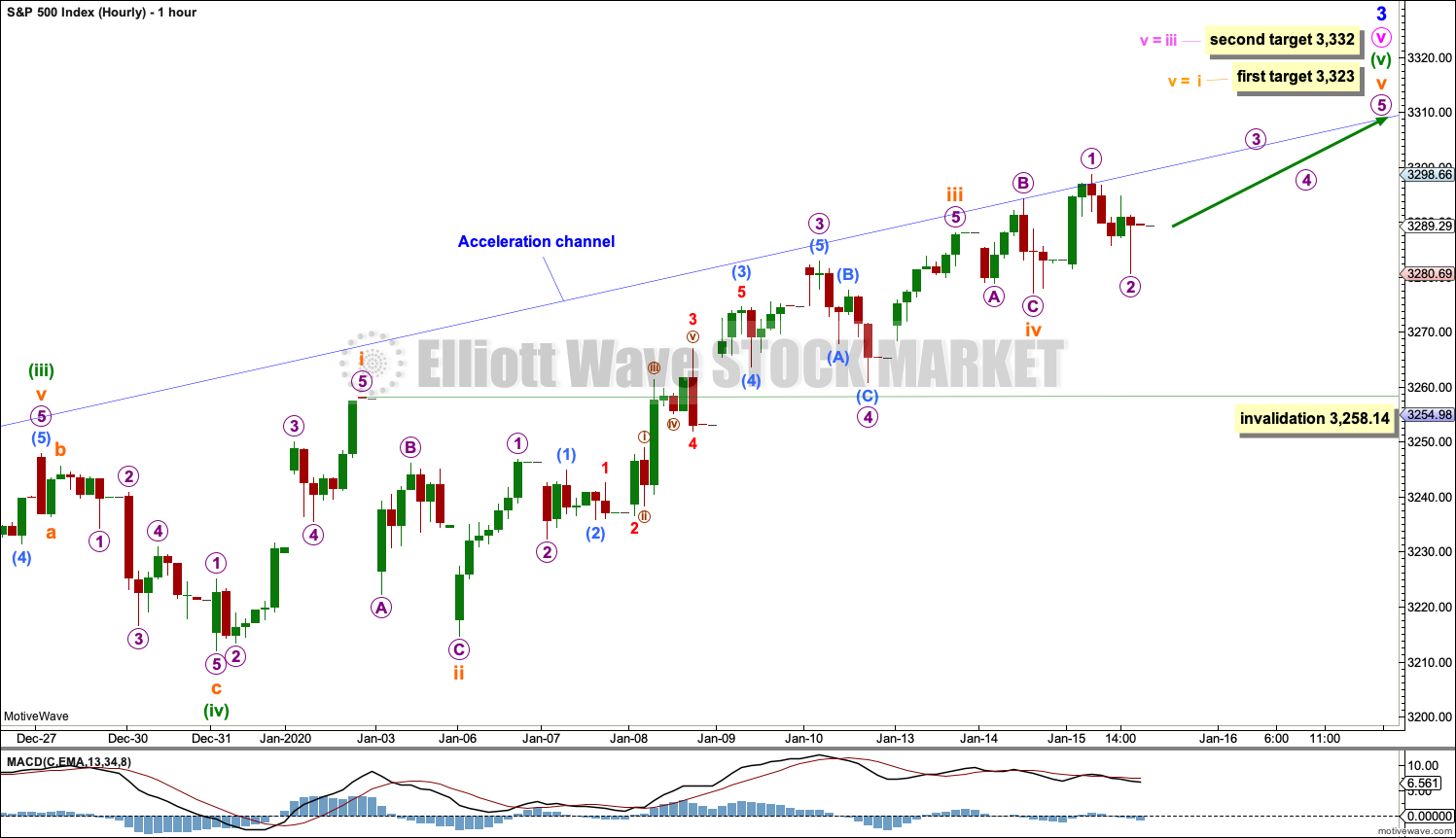
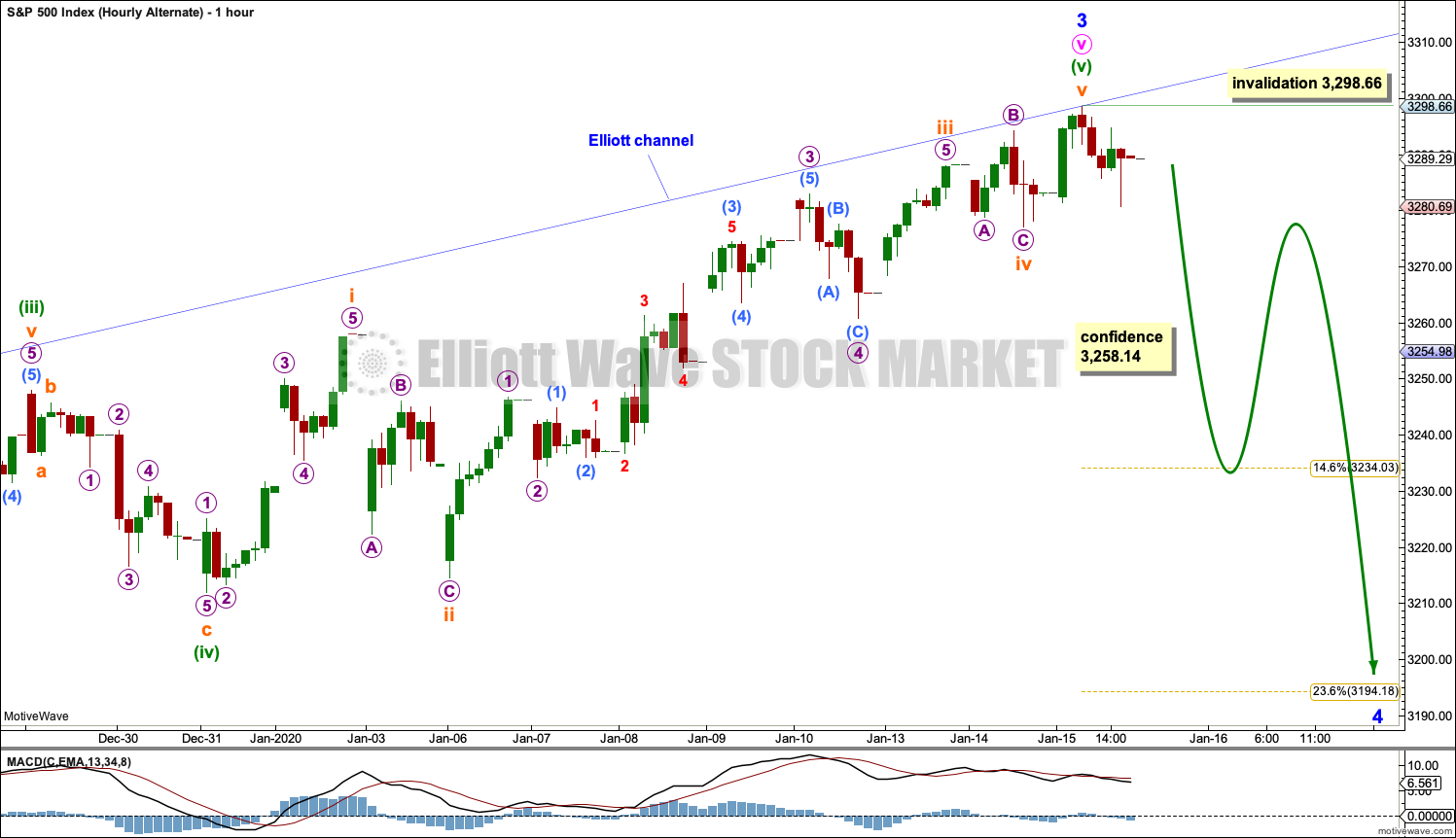
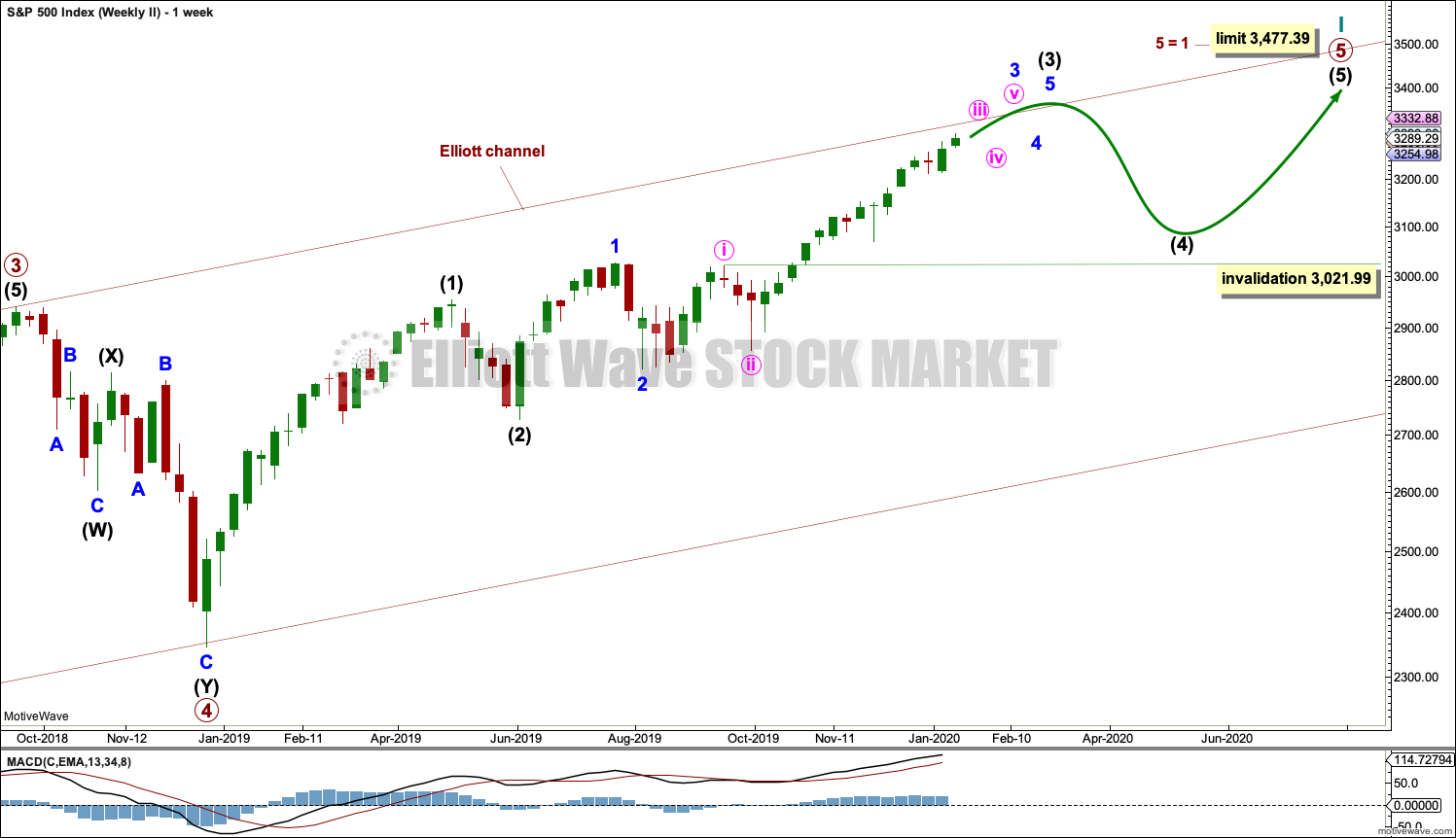
An instagrammable moment… except I don’t have an instagram account so I’ll just leave this here for you all
This was my work place yesterday. On the shores of Lake Tekapo, where the Church of the Good Shepherd is located with the snow capped Southern Alps in the distance.
It was a bit cold, but a very beautiful and peaceful place to work. That helps the thinking process IMO
I have been extremely busy (and admittedly challenged) since my husband past this year. I value those traders who are able to take time to comment and perhaps guide.
Thank you…especially to Lara, Kevin and Rodney
Thank you kindly.
You’re welcome Melanie. I am glad we are able to help in a small way.
Me too and I am so sorry for your loss.
Always good to keep the big picture in mind. Here’s one stressing periods after the recent set up of a monthly macd bullish crossover above the zero line and an exit from a squeeze (15 period Keltner’s outside of 20 period Bollinger’s). I’ve boxed up the following bullish action and put a copy of each box on top of the set up here. I have little doubt I could go back in time and find more similar “boxes”. Theory says price is generally headed to the upper right corner of each box…
Don’t over-expect a correction. Wait for it to announce itself. The bull can roar and roar and roar. Rodney’s tactic is a good one: just use the correction as an opportunity to get long with substantial reduction in risk by virtue of a low entry price and close by invalidation levels. Why counter trend trade here at all? The odds are NOT stacked in our favor like they are here to the long side; trends are VERY strongly up at monthly and weekly time frames. That’s edge, and shorting makes it negative edge, no matter how refined our entry technique. The easy way is lay back and float on this river going up, because the current is very strong.
How would you know where the low of minor 4 be to enter long positions?
5 waves up then 3 back on an hourly basis after time has shown the “right look” and possibly, alternation of minor 4 compared to minor 2.
Generally, you look for a reasonable combination of complete structure of a iv wave correction, at the “right” (roughly proportional) time period relative to the matching ii, and at the “right” (roughly proportional…but often iv’s are more shallow than ii’s) maximal low value (with guidance from the common behavior that the iv’s low lies in the range of the prior iv of one lower degree, i.e. the iv of the iii that leads to this iv).
And…you look for the very first signs that that’s all done, and impulsive action is starting, giving some confirmation to your analysis. That’s (arguably) the ideal time to get long.
Lara’s analysis helps tremendously re: the identification. She’s pretty good at it, lol!!
Long VIX futures could be a good strategy for minor 4.
Especially if minor 4 turns out to be a triangle as the first move down (wave A) will be the fast and biggest. So could be a good spike on VIX
Patiently holding a few mid Feb VIX calls at 13 here…
Hourly chart updated:
The invalidation point can now be moved up. Micro 4 may not move into micro 1 price territory.
Just a thought: we might have a pivot into minor 4 on 01/29/20 after Fed meeting. This is the closest and very probably fundamental catalyst that can trigger that switch.
I suspect 3-4 senators insisting on first hand witnesses at the impeachment trial could act a catalyst. And that could happen next week. Then there’s always “geopolitical” events that can happen semi-randomly, too.
Sometimes I really like butterflies.
Just found one in my portfolio I’d kind of forgotten about! IWM 168/170/172 for close tomorrow (1/17). Price current at 169.43. Fifty cents more at 3:45pm EST tomorrow puts that boat at the crest of the wave! Of course my real lunch money for the month is in SPX and RUT sold put spreads that close out at open tomorrow.
The challenge here is “what to do to make money at the next monthly options expiry?”. Because selling a boatload of put spreads under market into the teeth of this bull run is a bit concerning. Still thinking through what strategy and tactics to use.
The longer-term trend is still up. For me, being out of the market, the risk is lost potential profits. For those taking short positions into a clear uptrend, the risk is lost actual dollars. I will not short Minor 4. Intermediate 4 or Prinary 4 are a different matter. I may short those once a clear break of the uptrend is evident.
Your trading methods reduce risk and you discipline yourself well. The average trader has neither of these risk reduction actions.
Good strategy for minor four is tight (0.5 points) bear call spreads with short leg exit at break even…
The following chart was first presented here on October 15, 2019. It projected an unbelievable 20% move up in the NYSE. Today, it is looking more believable. However, as Lara says, these moves do not happen in a straight line. Look at the move up from February 2016 to January 2018. It contains a couple of notable corrections. The same will be true of the current bull move to my projected 15,800 NYSE.
The banter on consumer media is quite bullish. The rally is making headline news. At the beginning of 2019, Investor’s Intelligence reported bullish sentiment at 20%. Today, one year later, it stands at 60%. The high of January 2018 was 72%. But that was the completion of a Cycle 3 wave which has the highest MACD as well.
Bottom line, continued support for a correction sooner rather than later. By the way, the future Primary 4 correction may see a NYSE correction back to the red line on the chart, NYSE 13,600 which is roughly equivalent to SPX 3000.
NYSE could also correct to the yellow line, roughly 13,200 or 6.5%. Just saying.
In December monthly VIX closed just above its upper BB. Lets call it ‘right at its BB’. The current monthly VIX is clearly above its BB. The last time this happened was January 2018. The was followed by an SPX 340 point (12%) correction.
It also happened in March 2011 which was followed by 3 months continued up move. The correction came in May 2011 moving from SPX high of 1370 to a low of 1074. This was a 22% correction.
Today is not the same as Jan 2018 or March 2011. But it has some similarities. It points to the risk or danger of a correction. The correction itself may prove to be a wonderful buying (long) opportunity. I sold my longs last week. I did not get the absolute top dollar for them. This irks me. But I remember the old adage:
Bulls make money.
Bears make money.
Pigs get slaughtered.
Hourly VIX is right at its lower BB. Daily VIX is just a bit above its lower BB. It is refusing to go and stay below 12. We are at 30,000 on the DJIA and 3300 on SPX. If these levels cannot be held, we will see a reaction downward to 29,000 and 3200.
Have a good day all.
Congrats to those who shorted TSLA earlier in the week. I chickened out seeing the ramp on Monday to 546 but just hitting 497 premarket today. More to come I guess
I’ll look to buy the gap close around 478. Small position with calls …
Calls sold, lets see if this morning gap provides the next turn down….
Boom!
Futures just hit 3300
Boink.
Watch VIX. Correction on the horizon.
Rodney,
I see the same but waiting for it to take hold …..tick tock tick tock….
Where is wabbit ? Don’t see him posting here as he is the VIX expert?
Agreed. Just have a few SPY calls left.
Yep! We should see a VIX gap higher the next 48 trading hours…